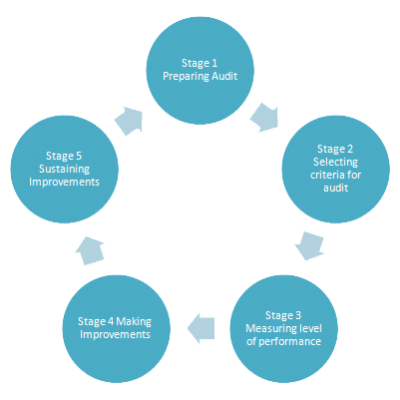The audit cycle
The process stages to audit:
The cycle progresses through the various stages to reach a fixed end point where the first phase is concluded. The cycle is then re-started by redefining the criteria, if appropriate setting new standards and collecting new data that will indicate whether or not the proposed changes have been effective. The diagram above illustrates a five stage audit; this is also sometimes known as the first audit cycle. An audit used for the purposes of revalidation is normally expected to contain eight stages normally measured against the same criteria but with the addition of a second phase of data collection, a comparison between the first data collection and the second, a commentary on improvements made and conclusions section reflecting the lessons learned and the likely impact on the system being measured. However other forms of Quality Improvement activity are also suitable.
Structure, process and outcome.

Agreement about the need for quality improvement in healthcare is universally accepted; however the means of achieving effective improvement in overall care is not well understood. Avedis Donabedian developed the structure–process–outcome framework which encourages consideration of quality improvement processes (Donabedian 1998).
Performance is often broken down into the three aspects: structure (what you need), process (what you do) and outcome of care (what you expect). You may choose to focus on one of these three components, or your audit might flow from one to another to include all three aspects in your design when formulating the appropriate criteria and standards (Glickman et al (2007), Irvine & Irvine (1991), Wakley & Chambers (2005).
Audit Methodology
When devising an audit project consideration should be given at the outset to the methodology which should be mapped out clearly and include defining the aim and objectives, developing criteria, ascribing standards, deciding data requirements, collection and collation. Finally agree a process for the analysis and reporting of results prior to team discussions regarding the review of audit findings, recommendations and planning changes. It is important that the methodology is well documented and progress fully recorded, noting any modifications to the original audit plan. This final point is vital for doctors who are offering an audit project as evidence of reflective learning and continuous professional development.


